Lithops, also called Living Stones, are native to the regions of southern Africa (Botswana, Namibia, South Africa). They are relatively small Succulents, known for their beautiful and sometimes stunning colors and leaf patterns. It is rather easy to grow your own lithops if you know what you’re doing.
Lithops Care
When growing Lithops and other Succulents it is very important to get the basics right. Soil, light, water and temperature. These are the main ingredients leading to successful cultivation and propagation of Lithops.
Soil
All Succulents need a soil with good drainage. Regular potting soil with 25% pumice, coarse sand or fine lave will do usually. Lithops prefers even more drainage. A percentage of at least 50% drainage material is good.
Light
Lithops plants need bright light but do not like too much intense direct sun for a long period during the day. A few hours of morning sun and bright but filtered sun light works best for my plants here in The Netherlands. Please note that seedlings and very young plants in general prefer some more protection from the sun. My Lithops plants do not get any direct sun light the first year after germination.
Water
Lithops species grow most actively in spring and autumn. They more or less in rest during the hot summer period. Always take this into account when you water your plants.
As mentioned above, a soil with perfect drainage is crucial to successfully grow your Lithops. These plants do not like wet feet for too long. The soil needs to be dry again in 1-2 days after watering them.
We water our Lithops plants 1 to 2 times a week in spring and autumn, depending on the temperatures and light conditions. Water sparingly with low temperatures in spring or autumn. We keep our Lithops almost dry in winter. In hot summer we water once a week usually and most of the time not more than a splash or a short spray with the garden hose.
Temperature
Lithops grow best at temperatures of 18-24 Degrees celsius. As mentioned above, thats spring and autumn. They can take very high temperatures in summer if they must. Avoid watering them too much when that happens and avoid direct sunlight.
Lithops Maintenance
Lithops maintenance is not that hard. Simple actually when you know what to do. Tip: Avoid any maintenance when the plant is actively growing in spring and autumn. The best time to remove old skin and trim roots is just before the period of growth starts again. Early spring and late summer. There are 4 important steps we take during our Lithops maintenance.
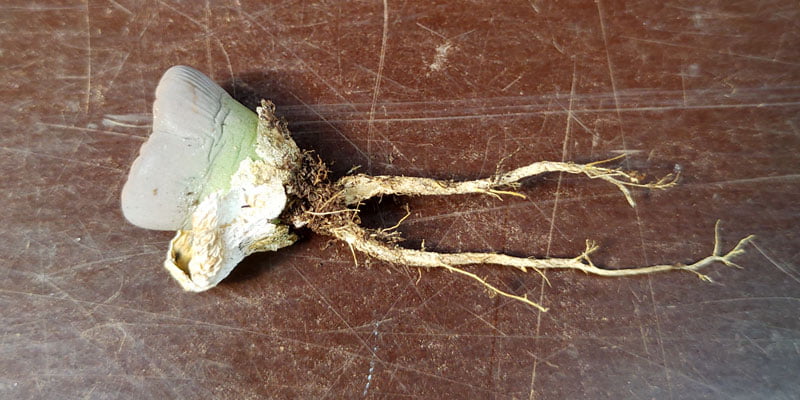
Step 1: Take the Lithops out of the soil
Carefully take the plant out of the soil. Do not start pulling the plant head like crazy, it will damage. Dig it out with a teaspoon. The roots can go quite deep! Another way is to just empty the entire pot with plants and soil if you want.
Step 2: Remove the old dry skin
Remove any old dried skin with a brush or gently pull it away from the plant. The dead skin has a purpose in nature where the plants grow in full sun outside. It protects the body underneath. So, feel free to leave it when you grow your plants outdoors. We remove it because it looks better and growth is slightly faster in the greenhouse. Probably because it can absorb more light for photosynthesis when the old skin is removed.
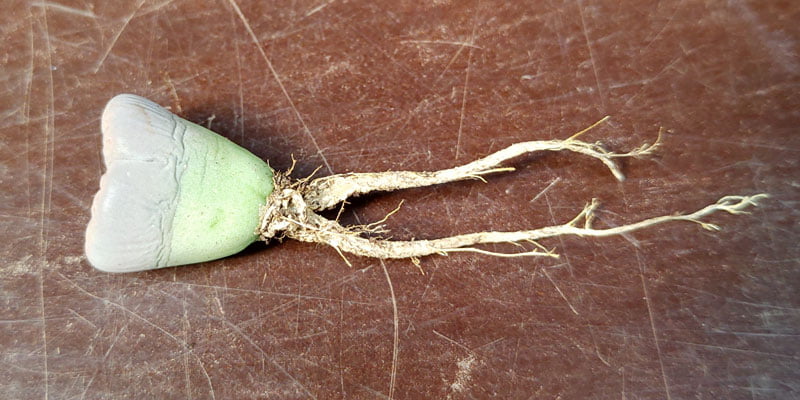
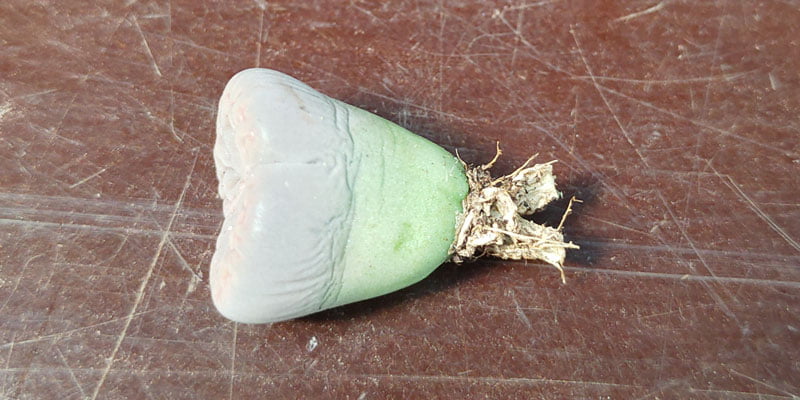
Step 3: Trim the roots
People sometimes wonder why we trim down the roots so far (0,5 – 1 cm). This promotes new and strong growth. The plant can settle better into the soil. You can plant Lithops without trimming the roots but it is important that the roots point straight down. They do not like their roots curled upward, It hinders their growth. Tip: Leave your trimmed Lithops for a couple of days before you plant it. The root cut needs to callus over.
Step 4: Plant your Lithops in fresh soil
The last step is obvious. Plant your Lithops in new, draining soil, with plenty of pumice, coarse sand or lava. Make sure that the plant head is almost level with the soil surface as visible in the picture.
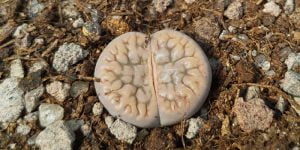
Lithops Propagation
Lithops are mostly propagated from seed. For us seed germination works best in spring, from March to April. You can buy seeds or you can try to get your owns seeds by pollinating your own Lithops plants with a small paint brush. You will get more individual plants of the same species. Gently brush the inside of the flower of a plant and then go to another plant to do the same. Brush as many flowers of different Lithops plants of the same species as you can. Pollination works best if your flowers come into contact with pollen of another plant.

Lithops germination steps
- Fill a pot with Succulent soil
- Add a thin top layer of pumice (Bims) or fine lava
- Divide the seeds evenly over the top layer
- Wash the seeds in with water
- Germination starts within 7-14 days
Lithops seeds germinate best at temperatures from 18-24C. You can cover the seed pot or tray with some transparent plastic to raise air humidity for germination. This is not needed if the air humidity where you are germinating the seeds, is allready high.
Lithops seedlings need good protecting, at least the first 3-4 months after germination. They do not like extremes. Keep your soil slightly moist, constantly, but not wet. Give the seedlings good filtered light during the day but avoid direct sun. Try to maintain steady temperatures. For example 20-24C during the day and 14-18C during the night.
Lithops FAQ
We get a lot of questions about Lithops. Below are some important ones. If you have some questions or remarks or other experiences growing Lithops, we would love you to contribute by replying to this post.
I received Lithops plants with almost no roots. Is this normal?
Yes. We trim the roots to 0,5-1 cm. The plants like it. It promotes new and healthy growth.
My Lithops plant feels soft and looks wrinkled. What should I do?
This is normal and usually occurs in summer when the Lithops body is losing some water. Nothing to worry about. You may occasionally mist the plant with some water on hot summer evenings. The body will get more firm again in autumn and spring when it is growing and when it is actively taking up more water through the roots.
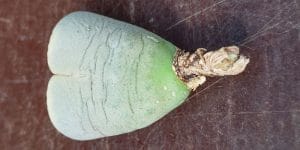
How deep should I plant my Lithops in the soil?
Make sure that the plant head is (almost) level with the soil surface.
My Lithops is growing very long and looks pale green.
Your plant is probably getting not enough light. Try to increase it slowly. It is also possible that the plant is getting to much water and fertilizer. When your Lithops is elongated (grown too long), it is hard (almost impossible?) to get a normal shaped plant again.

 Deutsch
Deutsch Nederlands
Nederlands Français
Français
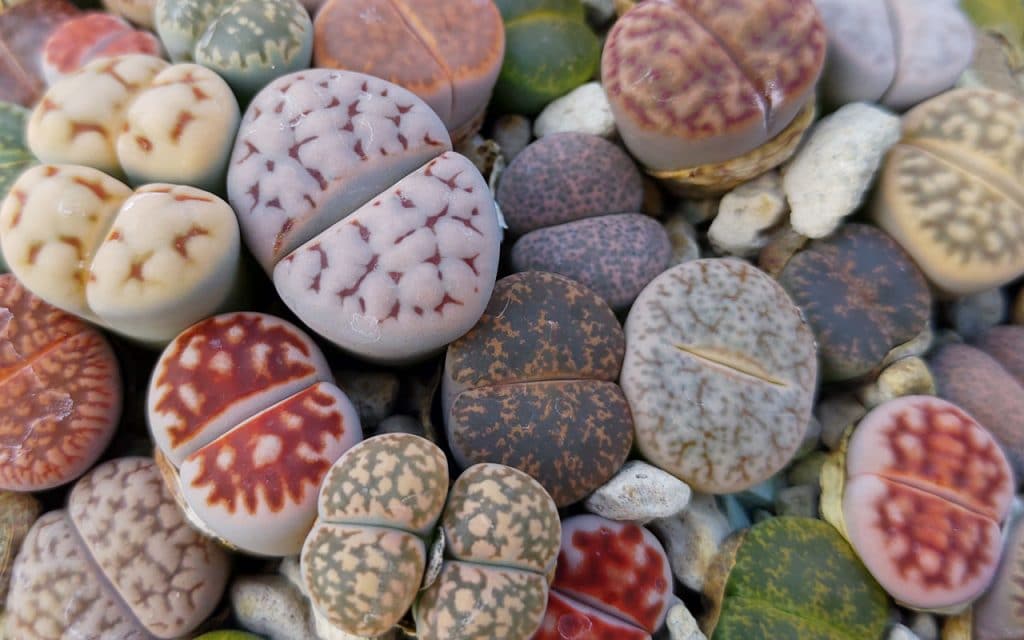
Bonjour
J’ai reçu mes lithops aujourd’hui
Je les ai placé dans une poterie ronde éspacés d’environ 1à2cm entre chaque lithops
Mais est t’il possible de les planter sérrés comme sur la pho de votre site
Autre question, je ne peux les mettre dehors et je les éclaire avec une lampe horticole , 12h par jour pouront t’ils vivre toujours en intérieur
Oui c’est possible. Avec un bon éclairage artificiel ou sur un rebord de fenêtre ensoleillé, vous pouvez les cultiver à l’intérieur.
I don’t know if this is normal or not but I’m very new to this I got some seeds and planted them on top of regular succulent soil not knowing I needed to put sand into it also but they’ve been sprouting they seem to have no support thought. they have one little root coming out and they seem to have no support to stand up most of them are standing up some of them are kind of wobbly is this normal if not what should I do
Thanks
Cover your Lithops seeds with some fine (1-3 mm) fine gravel and they will have support right after germination. Another method is to carefully add coarse sand around the growing seedlings. Personally I prefer the first method.
Today i bought my first lithops it looks like this, now after is repotted it in a bigger pot, when should i water it? I am living in Israel, early autumn here, everage temperature is 30 Celsius may be 28 at night.
(i dont see where i can add the picture)
hi, you can not add picture. Best water a little in the evening when the soil is completely dry.
Hello! Can I also plant my lithops in pure bims?
Yes you can. But you need to water more often and add a little fertilizer.
They have arrived, it’s end of July. I now pot them up in the special soil – when do I water for the first time?
I would water them after a week
I have hopefully followed your advice carefully – I purchased the special soil – I gave a small amount of water to the lithops after a week – avoiding the top of the plant- the largest just seemed to turn watery and curl up and die leaving only the two tiny ones which are ok. Suggestions as what went wrong?
Please sent me some pictures. Maybe it was too much water or too high air humidity.
I’m sorry I no longer have the little plant. It would possibly not be high humidity or overwatering – I only used a small amount of water and the plants are simply on a warm windowsill. Perhaps they are just difficult to grow – this is my first experience of Lithops – though I am experienced at looking after cactus and house plants. If any more die I will certainly take photos for you.
I no longer have the little lithops 🥲. I only gave a small amount of water and they are on a warm windowsill, with mature cactus which are more than happy. Perhaps it didn’t like the travelling or these succulents are just too difficult to grow. If any more die I will photograph.
Thank you for this blog! Very helpful. i was curious how long LIthops can stay wrapped in paper towel (that is now dry) until they can be planted. Can they be placed in the fridge to keep dormant or can I redamp the paper towel until they can be planted (approximately five days when my correct soil medium arrives). Thanks for your expertise. I absolutely love Lithops but mine usually start to die after a year and I want to make sure I do everything to keep them happy for the longterm.
Best take out the plants immediately after the arrive. Place them on a tabel, not too hot. Then plant them when you are ready. It is no problem to wait 5 days.
So, I live in the Caribbean and it’s always nice and Sunny (25-30C all year long), mostly humid at night and it barely rains. Can Lithops survive here if I slowly climatize them?
I would try a few plants and see how they do.
When the lithops double can you split them?
Some Lithops get a double head and then it ispossible to split them yes.
Very nice informative blog!
Question is it better to boil your water (and let it cool down) before usage for watering lithops? Or is this not needed? (Where I live the water is quite ‘hard’ )
How often do you need to repot mature lithops? And when to repot seedlings?
My lithops are currently on my windowsill, now the heat is not on but can I leave them here or do I move them when I turn on the heating?
When the lithop is elongated what is the best thing to do, leave it as it is or repot them deeper into the soil? (Or is it going to rotten)
Is it better to boil your water (and let it cool down) before usage for watering lithops? Or is this not needed?
No, it is not needed. However you could get white spots on the leafs because of the calcium carbonate. We do use a water softener and clean rainwater. Be careful using rain water from a rain barrel. It could house bugs of all kinds.
How often do you need to repot mature lithops? And when to repot seedlings?
Lithops can stay in the same pot for a very long time if you wish. Only repot when the pot is getting too small. They like small deep pots. We only repot seedlings when the seed tray is getting too crowded and when the Lithops seedlings are starting to push eachother out of the pot.
My lithops are currently on my windowsill, now the heat is not on but can I leave them here or do I move them when I turn on the heating?
They can stay on your windowsill as long as they are getting plenty of light. I would not worry about the temperatures.
When the lithop is elongated what is the best thing to do, leave it as it is or repot them deeper into the soil? (Or is it going to rotten)
I would leave it and see what happens when your light gets stronger.
ThNk you for the answers it helps me allot!
It was early this morning when I replied. I’ve an additionnal question, what kind of water softener do you use?
And with the heating I’m afraid that the ground and roots will dry out to hard. (From below because of the heating)
We use a salt-based softener. If the soil is dry faster then you can water more often.